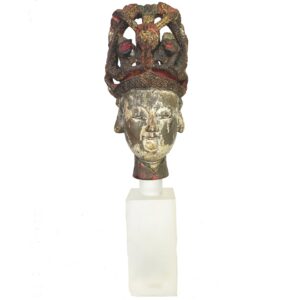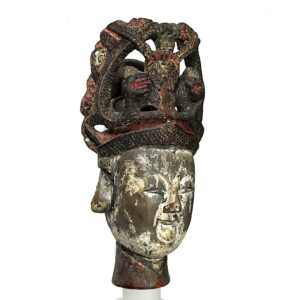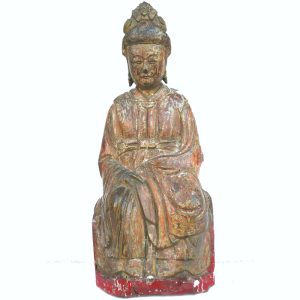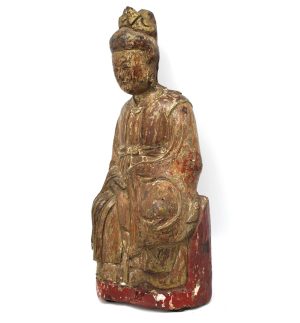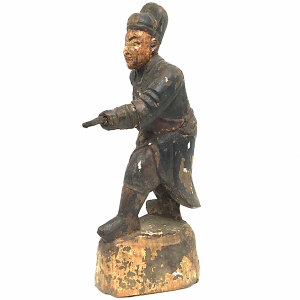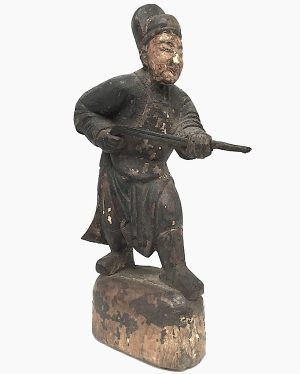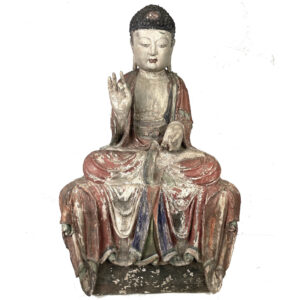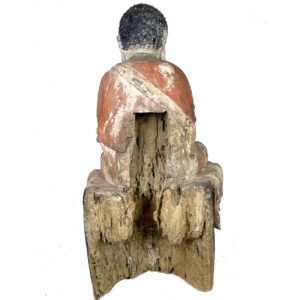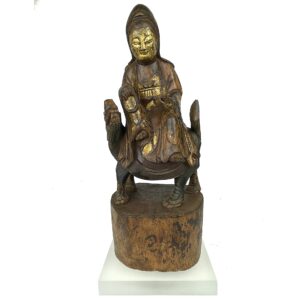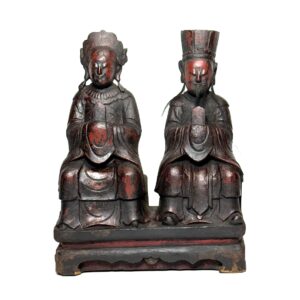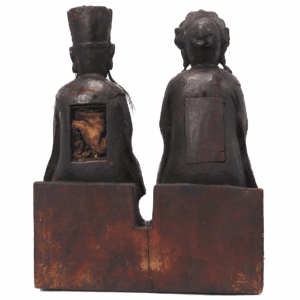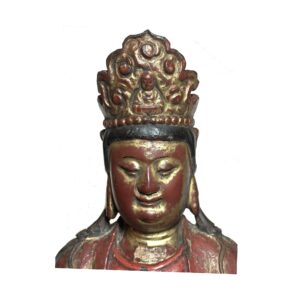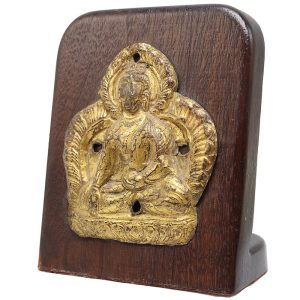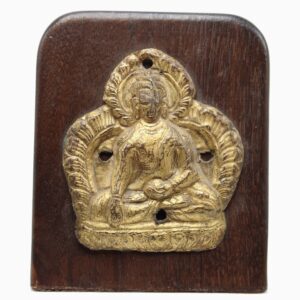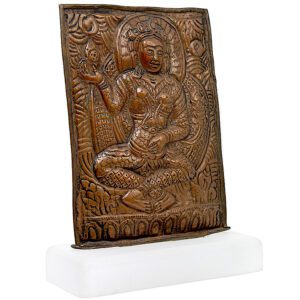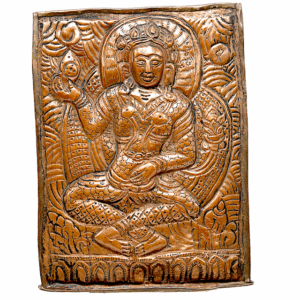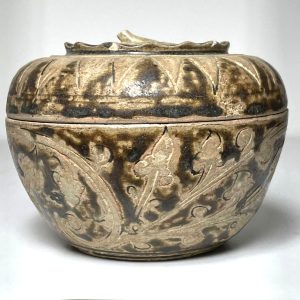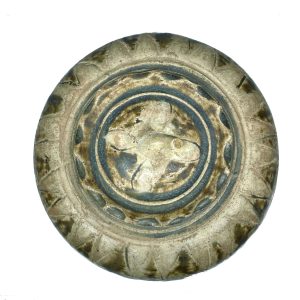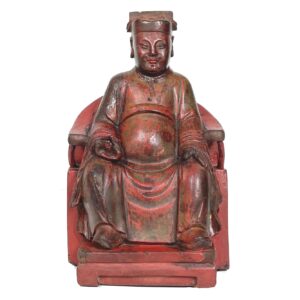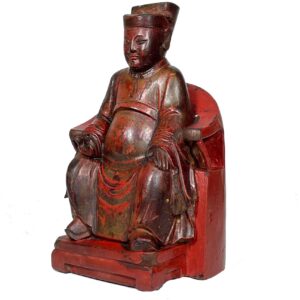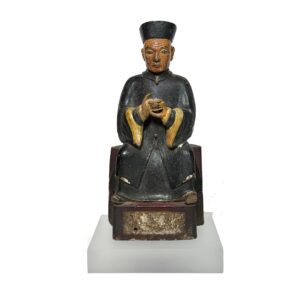Showing 97–108 of 248 results
-
Sale!


$785.00 Original price was: $785.00.$495.00Current price is: $495.00.
Ht: 17” W: 4.25” D: 4.5” | FREE SHIPPING WITHIN CONTINENTAL U.S.
Very rare depiction of Queen Mother of the West puppet head wearing elaborate headdress with outstretched tortoise legs atop a phoenix, reflecting early shamanism rites of turtle shell divination. Mounted on acrylic base.
-
Sale!


$525.00 Original price was: $525.00.$295.00Current price is: $295.00.
H: 11.25″ W: 4.6″ | 3.25″ FREE SHIPPING WITHIN CONTINENTAL U.S.
Dense hardwood Queen Mother carving with phoenix in crown, holding robe across body, calmly seated on backless throne, much original polychrome and lacquer finish remains. Sealed consecrated cavity.
-
Sale!


$315.00 Original price was: $315.00.$275.00Current price is: $275.00.
H: 9 ” W: 3.625″ D: 3.5 ” | FREE SHIPPING WITHIN CONTINENTAL U.S.
Unique ancestor figure of a huntsman in the round standing on a domed pedestal, holding a flint lock, wearing a hunting coat, a two-level hat, traditional under- and outer-garment, and thick boots.
-
Sale!


$4,500.00 Original price was: $4,500.00.$3,300.00Current price is: $3,300.00.
H: 30″ W: 18″ D: 10″ | | CALL 213-568-3030 OR EMAIL [email protected] FOR SHIPPING.
Superb, colorful and rare Buddha in teaching (vitarka) mudra appears to float above swirling cloud. Fine features, graceful body and exquisitely rendered drapery make this a truly striking statue. Given its size and masterful carving, it should be revered commensurate with its spirituality and artistry.
-
Sale!


$725.00 Original price was: $725.00.$585.00Current price is: $585.00.
H: 15.125” W: 6” D: 5” | FREE SHIPPING within Continental U.S.
Rare provincial carving of Guanyin in lalitsana clasping a rosary on a mythical Hǒu that symbolizes righteousness, morality and ushers in peace and prosperity. Small yet powerful, consecrated and mounted on Acrylic base.
-
Sale!


$995.00 Original price was: $995.00.$695.00Current price is: $695.00.
H: 10″ W: 7.75″ D: 8.25″ | FREE SHIPPING WITHIN CONTINENTAL U.S.
Rare single image of Kitchen God and wife, indicating their close/lasting relationship as family’s protectors. Detailed elaborate officials’ robes, headgear. Individually portrayed holding hu tablets like those held by high court officials or Taoist priests.
-
Sale!


$3,750.00 Original price was: $3,750.00.$2,900.00Current price is: $2,900.00.
H: 19″ W: 10″ D: 8″ | CALL 213-568-3030 OR EMAIL [email protected] for shipping INFORMATION.
Wonderfully carved Nanhai Guanyin with ornate and beautiful diadem centered by elaborately framed Buddha Amitabha in meditation. Vibrant aura radiates spirituality, opulence, serenity and strength, as well as compassion and grace, making this a truly masterful piece of art.
-
Sale!


$595.00 Original price was: $595.00.$495.00Current price is: $495.00.
with stand H: 5″ W: 4.6″ D: 4″ | FREE SHIPPING WITHIN CONTINENTAL U.S.
Tibetan repoussé of Shakyamuni Buddha in Earth Witnessing mudra within a trefoil arch on a lotus base.
-
Sale!


$250.00 Original price was: $250.00.$165.00Current price is: $165.00.
H: 7.5″ W: 5.75 D: 2.5″ | FREE SHIPPING WITHIN CONTINENTAL U.S.
Copper alloy repoussé votive plaque of Vishnu surrounded with head and body aureoles. Symbols of his power as Universe’s Protector include a conch shell, his crown and lotus leaves symbolizing purity, truth, and unfolding of creation.
-
Sale!


$385.00 Original price was: $385.00.$325.00Current price is: $325.00.
Ht: 3.375” Dia: 4.625” | FREE SHIPPING within continental U.S.
Sawankhalok elegant mangosteen shape stoneware lidded bowl with raised calyx, cream and brown glazes, incised floral and geometric designs to store spices, cosmetics, betel nuts and medicine.
-
Sale!


$650.00 Original price was: $650.00.$385.00Current price is: $385.00.
H: 7.25” W: 4.625” D: 3.5” | FREE SHIPPING WITHIN CONTINENTAL U.S.
Finely carved ancestor displaying status symbols: official’s attire and hat, horseshoe chair with feet on pedestal. Painted and lacquered front and back in red, traces of gilt, colors of “fu” as a wish for wealth, health and long life, aged from years of use into a great patina.
-
Sale!


$675.00 Original price was: $675.00.$495.00Current price is: $495.00.
Ht: 9″ W: 5″ D: 3.5″ | FREE SHIPPING WITHIN CONTINENTAL U.S.
Masterfully crafted Taoist official with calm, sincere and expressive face with creases indicating his age and wisdom of his senior status. Holds ritual cup with the elixir of immortality, a wish for a long and happy afterlife. Mounted on an acrylic stand.
End of content
End of content

